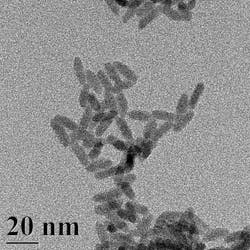Cadmium selenide quantum dots release toxicity in soil, say University of Buffalo scientists
Buffalo, NY--Scientists at the University of Buffalo have determined that cadmium selenide (CdSe) quantum dots degrade in soil, releasing their two toxic elements to the surroundings.1 Quantum dots made of CdSe are valuable in photonics, serving as single-photon sources, dopants for fiber sensors, sensitizers for photovoltaic cells, and luminescent markers for biomedical research (with the quantum dots sometimes fabricated with a shell of zinc sulfide to reduce toxicity). Many of these uses require only small quantities of the quantum dots.
"Quantum dots are not yet used widely, but they have a lot of potential and we can anticipate that the use of this nanomaterial will increase," said Diana Aga, who presented the findings in late June at a National Science Foundation funded workshop on nanomaterials in the environment. "We can also anticipate that their occurrence in the environment will also increase, and we need to be proactive and learn more about whether these materials will be a problem when they enter the environment."
Zinc sulfide shells not much help
In the lab, the researchers tested both bare CdSe quantum dots and zinc sulfide coated CdSe quantum dots, finding that both varieties of quantum dot leaked toxic elements within 15 days of entering soil.
In a related experiment designed to predict the likelihood that discarded quantum dots would leach into groundwater, the scientists placed a sample of each type of quantum dot at the top of a narrow soil column. The researchers then added calcium chloride solution to mimic rain.
Almost all the Cd and Se detected in each of the two columns—more than 90% of that in the column holding unshelled quantum dots, and more than 70% of that in the column holding shelled quantum dots—remained in the top 1.5 cm of the soil. But when the chelating agent ethylenediaminetetraacetic acid (EDTA) was added to the test columns instead of calcium chloride, the quantum dots traveled through the soil more quickly.
The data suggest that under normal circumstances, quantum dots resting in topsoil are unlikely to leach into underground water tables, unless chelating agents such as EDTA are introduced on purpose or naturally-occurring organic acids (such as plant exudates) are present. However, Aga said that even if the quantum dots remain in topsoil without contaminating underground aquifers, the particles' degradation still poses a risk to the environment.
"We can conclude from our research that there is potential for some negative impacts, since the quantum dots biodegrade," said Aga. "But there is also a possibility to modify the chemistry, the surface of the nanomaterials, to prevent degradation in the future."
REFERENCE:
1. Divina A. Navarro et al., Environmental Science and Technology, publication date (Web): June 22, 2011; DOI: 10.1021/es201010f.
Subscribe now to Laser Focus World magazine; it’s free!

John Wallace | Senior Technical Editor (1998-2022)
John Wallace was with Laser Focus World for nearly 25 years, retiring in late June 2022. He obtained a bachelor's degree in mechanical engineering and physics at Rutgers University and a master's in optical engineering at the University of Rochester. Before becoming an editor, John worked as an engineer at RCA, Exxon, Eastman Kodak, and GCA Corporation.
